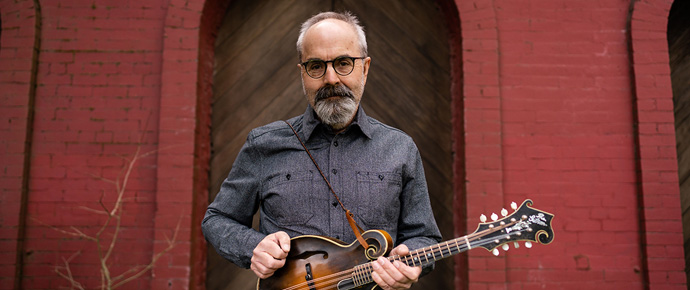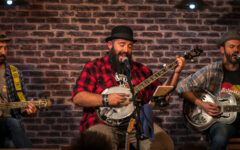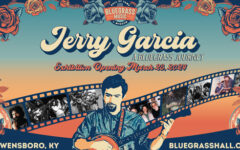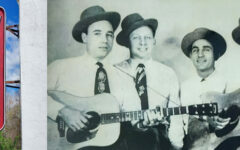
John Reischman – photo by Snap Jackson
Grammy winner, mandolinist, composer, and instructor John Reischman has way too many credentials to be listed here. His bio tells the story of a musician’s musician and master of many styles, yet his sound is distinctly his own. His influences are many but he has influenced many more. From the Good Ol’ Persons to the Tony Rice Unit, and his own John Reischman & the Jaybirds plus the Harmonic Tone Revealers, his work spans several eras and is extended by his latest solo album, New Time & Old Acoustic.
Hey John, what does the rest of your 2022 musical calendar looks like?
Well, it gets pretty busy starting in June. Lots of camps but also a good number of festivals. I’ll be back at the CBA music camp, and I’m also happy to report that John Reischman & the Jaybirds will be performing at the CBA’s Father’s Day Bluegrass Festival. In addition to the CBA camp, I’ll be at the Montana Fiddle Camp, the Swannanoa Gathering in North Carolina, the Rockygrass Academy, and NimbleFingers in British Columbia.
Other festivals that the Jaybirds will be performing at include Music from the Forest in Shelton, Washington, Blue Waters Bluegrass Festival near Spokane, Washington, and TradFest in Santa Fe. I’ll also be playing with some wonderful musicians based locally here in Vancouver. Trent Freeman and Patrick M’Gonigle on fiddles, Allison de Groot on banjo, Mark Kilianski on guitar, Joseph Lubinsky-Mast on bass, and me. The group is called Stringband Sundae because of a weekly Sunday night gig we had at a local club. It’s very part-time because of everyone’s various touring schedules, but we will be playing at the Vancouver Folk Music Festival.
This fall I’ll be playing some shows with the California Bluegrass Reunion. It’s a fun group of old friends: Darol Anger, Jim Nunally, Bill Evans, Sharon Gilchrist, and Chad Manning. It’s sort of an outgrowth of Bill Evans’ California Banjo Extravaganza, but with fewer banjos and more fiddles.
Has the band changed much since you got back out on the road?
I don’t think so. The Jaybirds are very happy to be out playing shows. We’ve got some new material which will hopefully lead to a new recording before too long.
Have you seen an uptick in online instruction in the last couple of years?
I don’t do a lot of private instruction, although I did some during the pandemic via Zoom. Most of my teaching is done at camps and through my two courses for Peghead Nation: Melodic Mandolin and Old-Time Mandolin. I’ve really enjoyed sharing tunes through Peghead Nation. A few camps opted to shift to Zoom over the past two years, but it looks like all the workshops I’m teaching this year will be in person.
Congratulations on the new album. It has a nice variety of tunes and players. How is this different from your previous releases?
Thank you. It’s stylistically a bit more varied. In addition to my originals that are influenced by bluegrass and old-time music, I wanted to revisit some of the “new acoustic” music I played in the ’80s. Other than that, it’s similar in approach to my album Walk Along John. Varied combinations of musicians playing my originals, for the most part.
Was it a challenge to get a consistent sound and vibe with the multiple sessions and locations?
Ivan Rosenberg, who mixed and mastered it, did a great job in making it sound cohesive even though it was recorded at several different studios. I have to give him the credit for making it flow sonically. Also, I approached each of the sessions with the same criteria: good studio and engineers, good mics, and musicians whose playing inspires me.
Are these tunes all new?
The tune Salt Spring has been around for a long time. I wrote it in 1999 or 2000, and the Jaybirds recorded it on our first CD. Then the live video we made became popular. I wanted to do a newer version with some of the young musicians I admire and have enjoyed playing music with: Alex Hargreaves, Allison DeGroot, Max Schwartz, and Molly Tuttle. Suzanne’s Journey and Ballyhooly were written in 2018 while I was on tour in Ireland with Greg Blake. Crescent Moon was a melody I’ve had for a while and I finally came up with a chordal accompaniment that I liked. The Fretless, and Trent Freeman in particular, did a wonderful job with the arrangement. The rest were mostly written in 2020 and a couple in 2021, so it’s mostly new material.
Did you release any singles? With all those great tunes, how do you go about choosing which to feature?
David Benedict, who’s a friend and a fantastic mandolin player, helped me with the publicity for this recording. He suggested releasing a few double singles based on the title – New Time & Old Acoustic. I thought it was a great idea to approach it that way and released one single representing the New Time, and the other Old Acoustic. The first ones were Salt Spring and Cascadia.
Is it harder to connect with a live audience playing instrumentals than, say, a vocal tune with nice harmonies?
That’s not been my experience. I find a slow tune with a beautiful melody and interesting chord changes—or a well-played, up-tempo tune—go over really well. I used to go see the original David Grisman Quintet, which was all instrumental, and the audience would go nuts!
A lot of instrumental tunes seem well suited for film. Has any of your work been in TV or films?
A while back I had two tunes from Up in the Woods licensed for a TV movie called Dodson’s Journey. They were filming in Vancouver and looking for bluegrass musicians for a scene. I took my CD to their production office and they called and said, “We can use these two tunes. Can you put a band together for the scene?” So I did, and it became a nice financial windfall for a few years, as the movie was shown in different markets around the world.
In the age of streaming, great tunes at the back of the album—like Rosco’s Ramble, The Old Steeple, and Dandy Longlegs—may get shortchanged. Is that something you think about when deciding the album order?
Not in the sense of tunes later on the album being shortchanged. I do think a lot about the sequencing and of the listening experience as a whole program, so I work around that. Start with a good first tune, then flow from tune to tune, and consider key relationships from one tune to the next.
At over seven minutes, Old Road to Kingham is fairly ambitious. Have you recorded tracks that long previously?
That’s the longest tune I’ve ever recorded. First of all, the form is long, with three parts, and there are three solos over the full form, plus an intro and outro. I definitely wanted this to have almost a jazz approach, where the soloists could improvise and develop their ideas. Todd Phillips and Chris Eldridge both played beautifully on this tune.
What surprised you about this release?
About five of these tunes were done during the pandemic and recorded one part at a time. I’d start by tracking the rhythm mandolin, then play the melody to that, and then I’d send it out to the various musicians to add their parts. It’s definitely not my preferred way to record, but I’m happy with how it all turned out. I think these tunes sound like everyone’s playing in the same room.
Tell us about the title New Time & Old Acoustic.
It’s just a play on the terms “new acoustic” and “old-time.” Some of my tunes are influenced by old-time music but they probably have too many chords, so I refer to them as new-time tunes. The CD also revisits some of the music I used to play that was referred to as “new acoustic.” That was 40 years ago though, so it’s not really new anymore. That’s where the “old acoustic” comes from. The title is basically something I think is funny!
I’ve seen you record snippets of melodies into your phone. Is that how most tunes get started?
The voice memo feature is very handy for remembering melodies on the fly. Tunes come to me in a variety of ways, so if I’m on a walk, and something occurs to me, I’ll hum the melody into my phone. I start by humming an arpeggio of the home key, then the melody. It makes it easier to decipher later.
Do you think about the instrumentation when composing?
Occasionally. For my tunes Nesser and Rosco’s Ramble, I wanted to write something that would sound good on the banjo. For Nesser I came up with the A part while walking, then developed the B part on the mandolin once I got home. I think Rosco’s Ramble had a similar origin. Other times the melody suggests the instrumentation or arrangement. The melody to Johnson Warhorse really benefitted with twin fiddles taking the lead.
Your tunes are for the most part not all that difficult to play compared to other tunes. Is that planned or happenstance?
I suppose it’s happenstance. It’s true, I don’t try to write anything that is intentionally technically challenging. I’m just trying to come up with melodies that sound good to me and hopefully don’t sound like other tunes. One thing that I enjoy is figuring out what chords sound the best behind any given melody. The right set of chords can make a melody stand out.
How do you go about selecting chords for a melody?
Well, one example is in Suzanne’s Journey. I decided it should be in the key of G. On the B part of the tune, the melody begins by sliding into an E note. My first instinct was to harmonize it with an E minor chord, but then I wanted to explore other options. I knew a C chord and an E minor both share two common tones—E and G, and once I tried the C chord instead of E minor, the tune sounded more distinctive to me. Learning a bit about chord substitutions can be very beneficial when harmonizing a melody.
A lot of your tunes are jam favorites. which must be rewarding. Is there ever a downside to that?
Not really. Although someone once sent me a picture taken at a jam of a little sign with Salt Spring crossed out! Like it was being played so much that it got banned from the jam session. Sort of like when you go to a music store and there is a sign forbidding the playing of Stairway to Heaven. I think it’s pretty funny. I’m honored that so many folks have picked up on my tunes. I’ve heard tell of all-Reischman-tunes jam sessions.
Have you always used open tunings or is it a more recent thing?
I started doing open tunings when I wrote the tune Ponies in the Forest in 1996. On that tune the E strings are tuned down to D, so it’s GDAD. I just tuned the mandolin that way and the tune came out fully formed. I also happened to be sleep deprived at the time, so maybe that added to the creativity. Old Road to Kingham, from my new CD, was also written in this tuning. It’s in B minor. I also like GDGD. I wrote the tune The Old Steeple in this tuning.
What’s your most Monroe-like tune?
Maybe Indiana Firefly? It was inspired by the Good Ol’ Persons’ trip to Bean Blossom in the ’80s and being in a place with all that bluegrass history. And it was the first time I ever saw fireflies! Also, Dandy Long Legs is reminiscent of some of Monroe’s later tunes.
How many instruments do you generally travel with and which ones?
I mostly always travel with my old Gibson. I’d sometimes bring my Lawrence Smart mandola when playing with Scott Nygaard and Sharon Gilchrist. On occasion, I’ll travel with my Michael Heiden F5. It depends somewhat on if it’s a driving trip or a flying trip.
The Harmonic Tone Revealers album is one of my favorites. Are there any plans for more recordings?
That was a fun recording to make. That trio (with Scott Nygaard and Sharon Gilchrist) was very part-time, mostly playing shows around the Bay Area. Then Sage Arts Studios, near Arlington, Washington, generously offered us studio time. We drove up there from the Bay Area, and I booked about five or six shows along the way there, so we were able to really dial into the music. That approach to recording is the ideal way to go about it. The studio is beautiful and sounded great. We set up pretty close to one another and didn’t use headphones so it was pretty natural. There were no overdubs, but we did a bit of editing on some tracks. For instance, if the mandolin solo was better on a different take than the best overall take, we might edit it into the master take. Nothing is scheduled as far as another recording, but you never know.
What did I forget to ask?
It would be good for folks to know that I’m a California native and still tour California several times a year. I love where I now live in British Columbia, but I keep a strong connection to the state where I was born, grew up, played a lot of music, and have so many friends.
Thanks for your time, John, and looking forward to seeing you at camps and festivals.
The CD can be purchased from John’s website and is available on the standard streaming sites.
John talking about his Lloyd Loar-signed Gibson F-5s
Copy editing by Jeanie Poling







